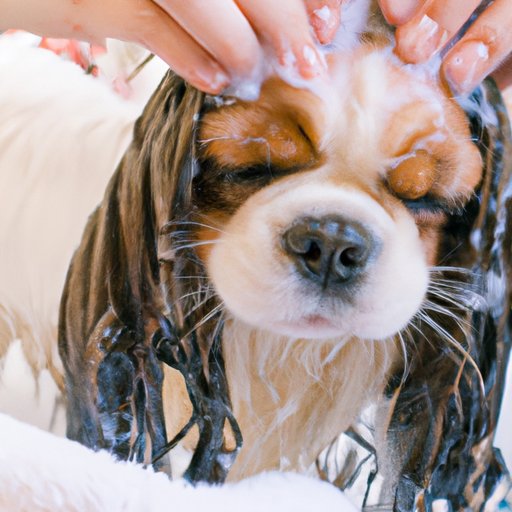Introduction
Regular bathing is an essential part of a dog’s grooming routine. Not only does it help keep them looking and smelling their best, but it also helps to keep their skin healthy and free of parasites, dirt, and debris. Knowing the right frequency for bathing your dog and using the correct products will ensure that your pup stays happy and healthy.
How Often Should You Wash Your Dog?
When it comes to deciding how often to bathe your pup, there are several factors to consider. The type of coat your dog has, their lifestyle, and any skin conditions they may have can all impact the frequency of baths. According to Dr. Ernie Ward, veterinarian and founder of the Association for Pet Obesity Prevention, “Generally speaking, I suggest bathing every 3-4 weeks.”
However, some dogs may need more frequent baths depending on their lifestyle. Dogs who spend a lot of time outdoors or are around other animals may need to be washed more often than those who stay mostly indoors. Longer-haired breeds will also require more frequent washing than short-haired breeds. If your pup has skin conditions such as allergies or dryness, talk to your vet about the best bathing schedule for them.
What Products to Use When Washing a Dog
When it comes to choosing the right products for your pup, it’s important to pick ones specifically designed for dogs. Human shampoos can be too harsh for a dog’s delicate skin, so it’s best to stick with pet-specific products. Look for a shampoo with natural ingredients like aloe vera, oatmeal, and chamomile, which are all known to soothe irritated skin.
In addition to shampoo, you may also want to use conditioner, detangler, and a flea and tick treatment. These products can help make it easier to brush your pup after a bath and protect them from parasites. Talk to your vet about the best products for your pup’s needs.

Tips for Making Sure Your Dog Enjoys Bath Time
Bathing your pup doesn’t have to be a stressful experience. Preparing your dog for the bath by brushing them beforehand and giving them plenty of treats during the process can help make it more enjoyable. Choose a spot in your home that is comfortable and familiar, such as a bathroom or laundry room. Make sure the water temperature is lukewarm, and use a cup or spray bottle to slowly wet your pup’s fur. Using a gentle massage motion when applying the shampoo and conditioner can help make the experience even more relaxing for your pup.

How to Tell if Your Dog Needs a Bath
It’s important to pay attention to your pup’s skin and fur to determine whether or not they need a bath. If your dog starts to smell bad or has visible dirt or debris in their fur, then it may be time for a bath. Additionally, check for signs of skin irritation and allergies such as redness, dry patches, or bumps. If you notice any of these symptoms, it’s best to consult with your vet before giving your pup a bath.

Common Mistakes to Avoid When Washing Your Dog
When washing your pup, it’s important to avoid certain mistakes that could cause harm to your pup. One of the most common mistakes is not brushing your pup before a bath. This can cause mats and tangles in your pup’s fur, making it difficult to rinse out the shampoo and conditioner. Additionally, avoid washing your pup too frequently. Overwashing can strip the natural oils from your pup’s skin, leading to dryness and irritation. Finally, make sure to rinse your pup thoroughly after the bath. Any leftover shampoo residue can cause skin irritation and itching.
Conclusion
Regular bathing is an important part of your pup’s grooming routine. Knowing the right frequency and products to use can help keep your pup clean, healthy, and happy. Generally, it’s best to bathe your pup every 3-4 weeks, but this may vary depending on their lifestyle and any skin conditions they may have. When washing your pup, use pet-specific products and be sure to brush their fur beforehand and rinse them thoroughly afterwards. Paying attention to signs of skin irritation and allergies can help you determine when it’s time for a bath. Following these steps will ensure that your pup enjoys bath time and stays healthy and happy.
(Note: Is this article not meeting your expectations? Do you have knowledge or insights to share? Unlock new opportunities and expand your reach by joining our authors team. Click Registration to join us and share your expertise with our readers.)
